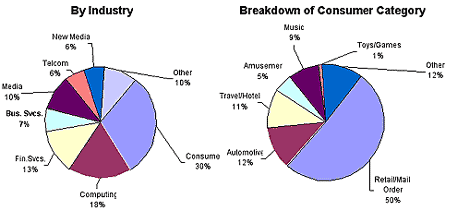New York, NY – September 24, 2001 – Internet advertising in the United States totaled $3.76 billion for the first two quarters of 2001, with Q1 accounting for $1.893 billion and Q2 coming in at $1.868 billion, according to the Interactive Advertising Bureau’s (IAB) Internet Ad Revenue Report, which is conducted independently by the New Media Group of PricewaterhouseCoopers.
The numbers reflect a decline in the overall advertising market during the first half of the year due to the softening economy. Online ad revenues declined 7.8 percent, from the same period in 2000, which is consistent with the other media revenue trends reported recently by Competitive Media Reporting (CMR). Measured against media that have similar short advertising buying cycles, unlike Network or syndicated TV which is bought upfront, online advertising was stronger in the last six months than Spot TV, which declined 14.7 percent, National Spot Radio, which was down 22.4 percent, and Sunday Newspapers, which lost 10.4 percent also according to CMR.
“We believe that the numbers we are reporting today must be viewed in the context of advertising overall. While the declines are not insignificant, they are well within the parameters of the overall advertising industry’s experience and seen in perspective, they reflect our confidence in the long term value of the online medium,” said IAB President & CEO Robin Webster.”
“This has been an important year for the Internet and online advertising. The Internet is recognized as a crucial source of information and usage is growing worldwide. During the past six months, IAB members have made impressive strides in developing new ways of advertising online, creating effective campaigns and measuring their success,” noted IAB Chairman, Shelby Bonnie. “Ours is a dynamic medium that, even in a slowing economy, has shown that it is gaining advertisers’ trust relative to other media.

The consumer-targeted category continues to be the largest overall segment (30 percent) with the
retail segment of the consumer category (50 percent +10 points) driving ad revenues.
Consolidation within the industry for the first six months of 2001 continues, with revenues more heavily consolidated within large media companies.
| January – June 2001 | January – June 2000 | |
| Top 10 Media Companies | 76% | 70% |
| Top 25 Media Companies | 88% | 83% |
| Top 50 Media Companies | 96% | 91% |
CPM is the Dominant Pricing Model.
The CPM pricing model is the model of choice, comprising 50 percent of all deals, while straight performance contracts remained flat at 10 percent.
Percentage of Internet Ad Revenue by Pricing Model
January – June
| 2001 | 2000 | 1999 | |
| Straight CPM | 50% | 43% | 42% |
| Hybrid | 40% | 47% | 51% |
| Straight Performance | 10% | 10% | 7% |
“This is a healthy trend for the industry. Pricing models based on the variables publishers control such as audience, space and editorial environment, are much more reliable than those which are outside the publisher’s control, such as the strength of the agency’s creative and/or the advertiser’s service or product,” said Webster.
In the first half of 2001, 90 percent of the revenue transactions were cash based (94 percent in the first half of 2000) with barter/trade at 9 percent (5 percent for the first half of 2000). Package deals remained the same at 1 percent.
Internet ad revenues reported by participating companies to PwC include both cash and barter revenues. The reporting of cash and barter revenues is in accordance with traditional media industry practice and generally accepted accounting principles (GAAP).
Ad Formats Diversify
The innovation that was a keynote of online advertising during the first six months of 2001 is reflected in the many ways that companies chose to advertise. The different ad formats tracked and their respective share of revenue for the first six months of 2001 are:
| Format | Jan – June 2001 | Jan – June 2000 |
| Banners | 36% | 51% |
| Sponsorships | 28% | 27% |
| Classifieds | 15% | 5% |
| Slotting Fees | 8% | N/A |
| Interstitials | 3% | 3% |
| Key Word Search | 3% | 1% |
| Referrals | 2% | 3% |
| Rich Media | 2% | 2% |
| 3% | 3% | |
| Other | 0% | 5% |
“As the industry continues to develop, the IAB/PwC Internet Ad Revenue Report has tracked the evolution of the various ad formats,” noted Tom Hyland, Chair, PricewaterhouseCoopers New Media Group. “Classified ads increased 176 percent in dollars versus a year ago, and represent 15 percent of the total revenues for the first half of the year. This is the first year we have identified slotting fees – the fee charged for premium ad placement and/or exclusivity- which made up 8 percent of the revenues for the first two quarters of 2001. Banners, while decreasing, are still the predominant format, contributing more than one-third of online revenues.”
Conducted by the New Media Group of PricewaterhouseCoopers on an ongoing basis, with results released quarterly, the “Advertising Revenue Report” was started by the IAB in 1996, and represents data from all companies that sell meaningful online advertising revenues. The results reported are the most accurate measurement of online advertising revenues because the data is compiled directly from information supplied by companies selling advertising on the Internet. All-encompassing in nature, the survey includes data concerning online advertising revenues from Web sites, commercial online services, free e-mail providers, and all other companies selling online advertising.
About PwC
PricewaterhouseCoopers (www.pwcglobal.com), the world’s largest professional services organization, helps its clients build value, manage risk and improve their performance. The PricewaterhouseCoopers New Media Group — with offices in New York, Los Angeles, Seattle, San Francisco Bay Area, and Boston — combines content and technology specialists to provide comprehensive service to dynamic entrepreneurial companies. Services include management consulting, business assurance services, ad delivery and privacy attestation and consultation, assistance with mergers and acquisitions, tax planning and compliance, capital structuring and employee benefits and executive compensation packages.
About the IAB
Founded in 1996, the IAB is the industry’s leading interactive advertising association. Its activities include evaluating and recommending guidelines and best practices, fielding research to document the effectiveness of interactive media, and educating the advertising industry about the use of interactive advertising and marketing. Membership includes companies that are actively engaged in the sale of interactive advertising and marketing.
Content:
Marla Nitke IAB



